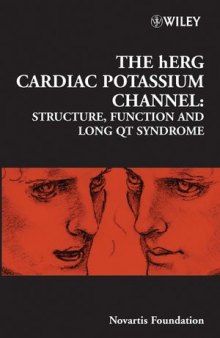 جزییات کتاب
جزییات کتاب
This book draws together contributions from basic, pharmaceutical and clinical sciences aimed at a better understanding of the structure and function of hERG and the molecular basis for compound binding. It features regulatory authority perspectives on preferred preclinical test systems and includes topics on hERG channel gating, regulation of functional expression, pharmacological properties of hERG/IKr channels, drug-induced long QT syndrome and preclinical evaluation and regulatory recommendations for assessing QT prolongation risks. Better understanding of the role of the hERG channel in drug-induced cardiac arrhythmias should ultimately lead to the development of important, new and safer medicines.Content: Chapter 1 Chair's Introduction (pages 1–3): Michael C. SanguinettiChapter 2 Gating and Assembly of Heteromeric hERG1a/1b Channels Underlying IKr in the Heart (pages 4–18): Gail A. Robertson, Eugenia M.C. Jones and Jinling WangChapter 3 Structure–Function Studies of the Outer Mouth and Voltage Sensor Domain of hERG (pages 19–43): Gea?Ny Tseng and H. Robert GuyChapter 4 General Discussion I (pages 44–45): Chapter 5 Voltage Sensor Movement in the hERG K+ Channel (pages 46–56): David R. Piper, Michael C. Sanguinetti and Martin Tristani?FirouziChapter 6 hERG Channel Trafficking (pages 57–74): Eckhard Ficker, Adrienne Dennis, Yuri Kuryshev, Barbara A. Wible and Arthur M. BrownChapter 7 Dynamic Control of hERG/IKr by PKA?Mediated Interactions with 14?3?3 (pages 75–94): Anna Kagan and Thomas V. McDonaldChapter 8 General Discussion II (pages 95–99): Chapter 9 Does hERG Coassemble with a ? Subunit? Evidence for Roles of MinK and MiRP1 (pages 100–117): Arun Anantharam and Geoffrey W. AbbottChapter 10 hERG Block, QT Liability and Sudden Cardiac Death (pages 118–135): Arthur M. BrownChapter 11 Structural Determinants for High?Affinity Block of hERG Potassium Channels (pages 136–154): John Mitcheson, Matthew Perry, Phillip Stansfeld, Michael C. Sanguinetti, Harry Witchel and Jules HancoxChapter 12 General Discussion III (pages 155–158): Chapter 13 Physicochemical Basis for Binding and Voltage?Dependent Block of hERG Channels by Structurally Diverse Drugs (pages 159–170): Michael C. Sanguinetti, Jun Chen, David Fernandez, Kaichiro Kamiya, John Mitcheson and Jose A. Sanchez?ChapulaChapter 14 In Silico Modelling?Pharmacophores and hERG Channel Models (pages 171–185): Maurizio Recanatini, Andrea Cavalli and Matteo MasettiChapter 15 The Long QT Syndrome: A Clinical Counterpart of hERG Mutations (pages 186–203): Peter J. SchwartzChapter 16 Cellular Mechanisms of Torsade de Pointes (pages 204–224): Steven Poelzing and David S. RosenbaumChapter 17 Expression and Role of hERG Channels in Cancer Cells (pages 225–234): Annarosa ArcangeliChapter 18 TRIad: Foundation for Proarrhythmia (Triangulation, Reverse Use Dependence and Instability) (pages 235–250): Luc M. HondeghemChapter 19 Drug?Induced QT Interval Prolongation—Regulatory Guidance and Perspectives on hERG Channel Studies (pages 251–285): Dr. Rashmi R ShahChapter 20 Closing Remarks (pages 286–287): Michael C. Sanguinetti



 دانلود کتاب
دانلود کتاب

 جزییات کتاب
جزییات کتاب





 این کتاب رو مطالعه کردید؟ نظر شما چیست؟
این کتاب رو مطالعه کردید؟ نظر شما چیست؟
